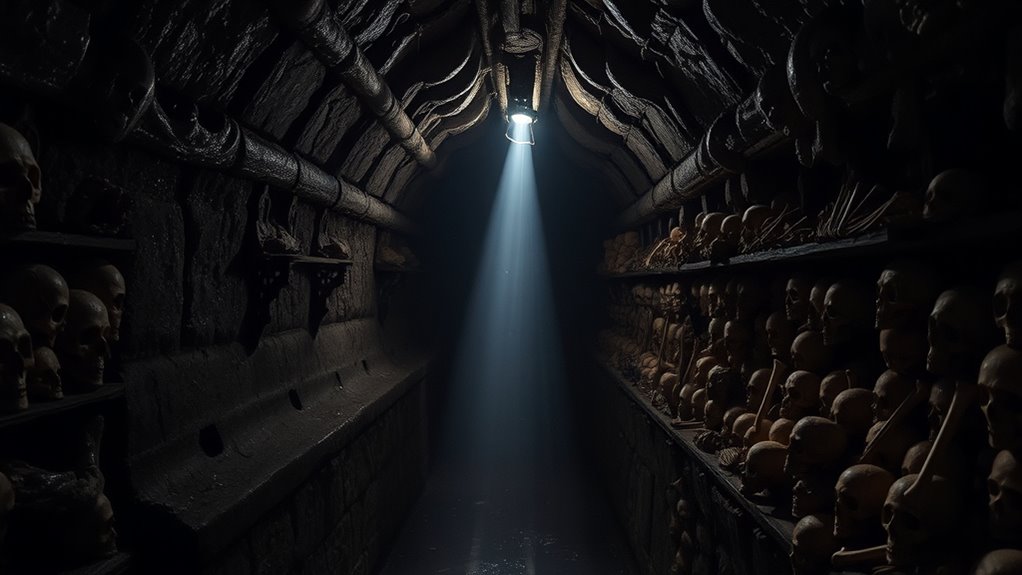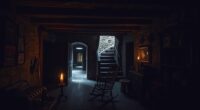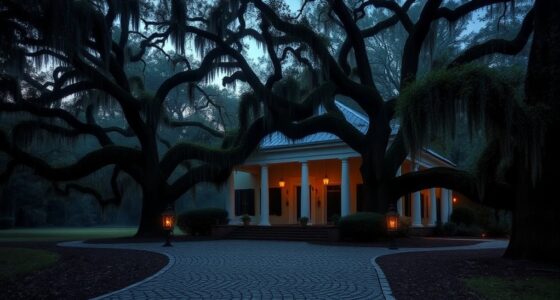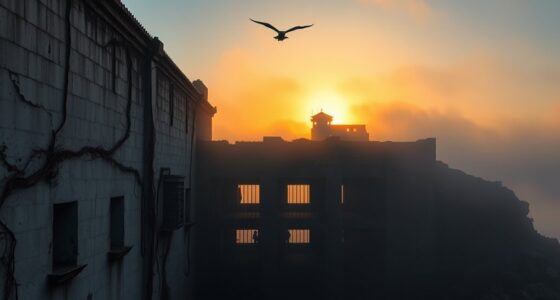The Catacombs of Paris invite you to explore an eerie underground world that houses the remains of six million people. Originally quarried for limestone, they transformed into an ossuary in the 18th century due to overcrowded cemeteries. As you navigate the dark, winding tunnels, you’ll encounter unique features like the “bone wall” and the “throne of skulls.” Respectfulness is vital here, as you uncover the haunting legacy and cultural significance hidden beneath the city’s streets. There’s much more to discover.
Key Takeaways
- The Catacombs of Paris house the remains of six million people, relocated from overcrowded cemeteries between 1738 and 1825.
- Unique features like the “bone wall” and “throne of skulls” reflect the eerie aesthetic and history of the site.
- Exploration requires essential gear, including headlamps and sturdy footwear, to navigate the muddy and narrow passages.
- Visitors are urged to respect the remains, adhering to unwritten rules upheld by the cataphile community.
- The catacombs serve as a cultural reflection on mortality and memory, embodying themes of life, death, and the significance of remembrance.
The Enigmatic History of the Catacombs

As you explore the enigmatic history of the Catacombs of Paris, you’ll discover a fascinating tale that began in the 13th century, when these tunnels were originally carved out for limestone quarrying. This quarrying provided vital materials for the city’s grand structures.
However, by 1738, Paris faced overcrowded cemeteries, leading to the relocation of over six million human remains into the catacombs, a process that continued until 1825.
In 1738, Paris began relocating over six million remains to the catacombs due to overcrowded cemeteries, a process lasting until 1825.
Spanning around 200 miles beneath the city, the Paris catacombs feature remarkable displays like the “bone wall” and historical carvings from 1705, emphasizing their cultural significance.
While these tunnels attract visitors drawn to their rich history, it’s important to approach this site with respect for the human remains housed within.
Preparing for an Underground Adventure

Exploring the Catacombs of Paris is an adventure filled with intrigue, but it requires careful preparation to guarantee a safe and enjoyable experience. Make certain you pack essential gear for your journey.
| Essential Gear | Purpose |
|---|---|
| Headlamps | Illuminate dark tunnels |
| Identification | Required at police checkpoints |
| Appropriate Footwear | Navigate muddy and narrow passages |
| Extra Batteries | Make certain your devices stay powered |
Stay aware of potential risks, such as aggressive cataphiles and theft, especially if you’re exploring alone. Familiarize yourself with the layout using digital maps created by experienced explorers. For the past five years, safety checks for air and water quality have been crucial to make certain a smooth adventure. Additionally, consider bringing solar-powered lighting solutions to ensure visibility in the dimly lit areas of the catacombs.
Navigating the Dark Tunnels

How do you navigate the labyrinthine tunnels of the Catacombs of Paris without losing your way?
First, wear proper footwear and gear—those narrow, muddy passages often require crawling or laying down to pass through. Prepare for a six-hour exploration where you might encounter claustrophobic spaces.
Understanding the layout is essential; digital maps from seasoned visitors can be lifesavers in this extensive network. Keep your ID handy for police checkpoints and stay alert to potential risks from aggressive cataphiles.
Navigating the Catacombs requires a solid understanding of the layout; digital maps and your ID can be crucial for safety.
Prioritize safety by ensuring the air quality is adequate and staying hydrated. By maintaining awareness of your surroundings, you’ll enhance both your safety and experience while weaving through these dark, historical tunnels.
Unique Features of the Catacombs
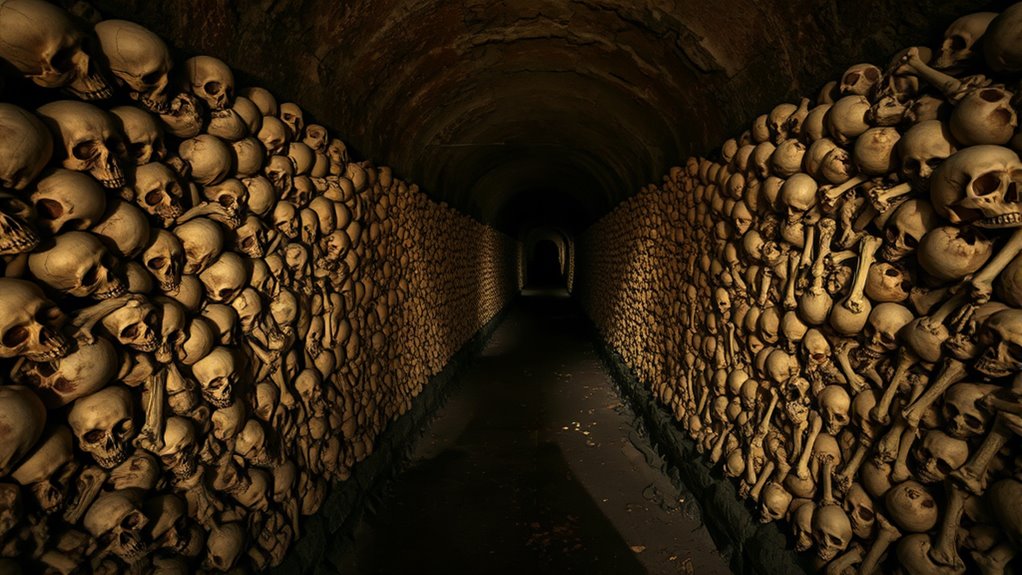
As you explore the Catacombs of Paris, you’ll encounter bone walls and intricate carvings that tell stories of the past.
Unique spaces like the “throne of skulls” and the “monk room” highlight both the historical significance and the artistry of this underground world.
Each passageway reveals not just remains, but a glimpse into the culture and community that thrives in these shadowy depths.
Bone Walls and Carvings
While wandering through the Catacombs of Paris, you’ll encounter the haunting beauty of the “bone walls,” which are crafted from the remains of over six million individuals.
These walls showcase intricate arrangements of skulls and bones, creating a chilling yet fascinating visual landscape.
You’ll also discover unique features, including:
- Historical carvings dating back to 1705, particularly in the “monk room”
- A throne of skulls, epitomizing the eerie aesthetic of the catacombs
- Claustrophobic passageways that force you to navigate on your stomach
- Artistic bone formations embedded within the walls
- The overall macabre history that enriches your exploration experience
These elements highlight the Catacombs’ unparalleled nature as a historical and cultural site.
Historical Significance and Structures
The Catacombs of Paris stand as a tribute to the city’s complex history, intertwining the macabre with remarkable artistry. Established in the 13th century, these tunnels house over six million bodies, showcasing unique features that draw visitors from around the world. You’ll encounter structures like the “throne of skulls” and intricate carvings dating back to 1705. The bone walls and skull carvings are striking, reflecting both the artistry and the somber narratives of those interred.
| Feature | Description | Year Established |
|---|---|---|
| Throne of Skulls | Church-like structure of skulls | 1738 |
| Bone Walls | Walls made of human bones | 1738 |
| Intricate Carvings | Decorative carvings in tunnels | 1705 |
| Historical Shift | 50-year process of body relocation | Late 17th-1825 |
| Dark Tourism | Popular attraction for history buffs | Ongoing |
Unique Passageways and Spaces
Have you ever wondered what secrets lie within the winding tunnels of the Catacombs of Paris? As you explore this eerie maze, you’ll discover unique passageways and spaces that tell gripping stories.
Here are some highlights:
- Over 200 miles of tunnels, with cramped areas forcing you to crawl or lay on your stomach.
- The “throne of skulls,” a chilling reminder of the site’s history.
- The “monk room,” featuring historical carvings from 1705.
- A “party room,” where some visitors have turned solemn spaces into social spots.
- Artistic bone formations, including a striking “bone wall” made of skulls and femurs.
These features showcase the catacombs’ macabre creativity and historical significance, making them a must-visit for the adventurous.
Cultural Significance and Ethical Considerations
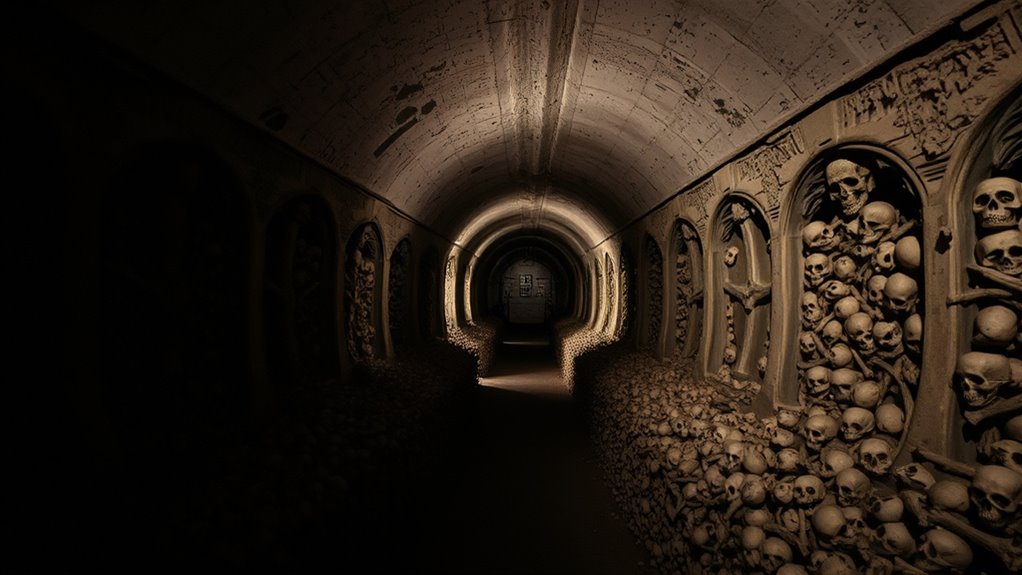
Exploring the Paris catacombs reveals not only a fascinating historical narrative but also raises important ethical reflections regarding the treatment of human remains. With over six million bodies resting here, the catacombs embody cultural practices surrounding death since the late 17th century. Visitors must respect these remains, avoiding stepping on bones to honor the dead. The cataphile community enforces unwritten rules to maintain the sanctity of the site, blending reverence with exploration. As a form of dark tourism, the catacombs challenge you to ponder the dignity of those who lie beneath.
| Aspect | Description | Ethical Consideration |
|---|---|---|
| Historical Significance | Reflects burial practices since the 17th century | Treat remains with respect |
| Cataphile Culture | Unwritten rules and rites | Protecting site sanctity |
| Dark Tourism | Interest in macabre history | Balancing curiosity with dignity |
Filming Challenges in the Depths

While exploring the depths of the Paris catacombs, filmmakers encounter a unique set of challenges that demand both creativity and respect for the site.
You’ll need to navigate various obstacles to capture the eerie essence of this underground world:
- Strict regulations limit extensive recording and require sensitivity to the presence of cataphiles.
- Noise interference from other visitors complicates sound capture, disrupting the film’s atmosphere.
- Safety checks for air and water quality are essential to guarantee crew well-being in confined spaces.
- Limited visibility in dark tunnels makes headlamps necessary, affecting camera work.
- Narrow, muddy passages often force the crew to lay on their stomachs, complicating movement and filming logistics.
These factors add complexity but also enrich the storytelling experience.
The Haunting Legacy of the Catacombs
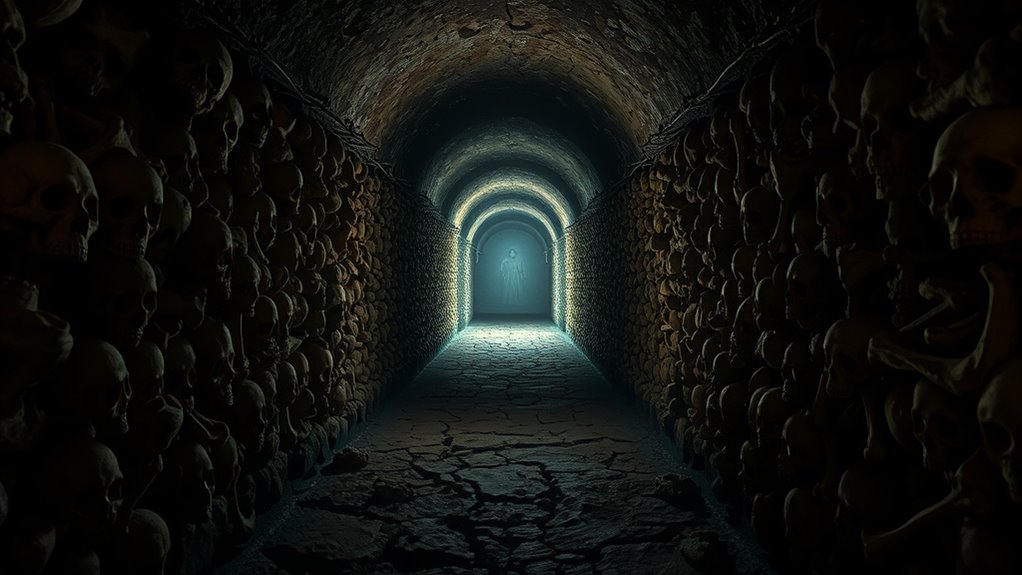
As you explore the haunting legacy of the Paris catacombs, you’ll uncover a profound history that intertwines life, death, and culture.
Housing over six million bodies, these tunnels emerged from 13th-century limestone quarrying, evolving into a resting place for millions over 50 years.
Unique features like the “throne of skulls” and intricate bone walls reveal the site’s dark allure and historical significance.
As a form of dark tourism, the catacombs attract those seeking to understand their cultural impact while emphasizing respect for the remains.
Interacting with the cataphile community, you’ll witness rites such as baptism, underscoring the importance of acknowledging the traditions that honor those who rest below.
The catacombs truly embody a haunting yet reverent legacy.
Frequently Asked Questions
Did They Film as Above, so Below in the Real Catacombs?
Yes, they did film “As Above, So Below” in the real catacombs of Paris.
You’ll find it fascinating that the filmmakers secured special permission from the French government for this project. They used authentic skeletons and minimal props, which added to the film’s eerie vibe.
Maneuvering through the narrow, dark tunnels without electricity posed significant challenges, but it enhanced the overall atmosphere and horror elements that you can experience in the film.
Who Was the Girl Lost in the Catacombs?
You might remember the tragic tale of a girl who wandered too far into the shadows of the catacombs, getting lost in their labyrinthine embrace.
She became separated from her friends, and despite extensive searches, she vanished without a trace.
This haunting story serves as a reminder of the hidden dangers lurking beneath the surface.
It urges you to tread carefully and respect the depths, ensuring that your adventures remain safe and memorable.
What Did the Police Discover in the Catacombs in 2004?
In 2004, police discovered an underground film studio in the catacombs, complete with a projection room and a collection of films.
They also found evidence of a large, illegal rave party that had recently occurred, highlighting the secretive nature of the cataphile community.
Makeshift living quarters and various art installations were uncovered, prompting authorities to address the ongoing issues of trespassing and safety in these historically significant tunnels.
Who Was the Man Who Got Lost in the Catacombs?
The man who got lost in the catacombs is Maxime D. He ventured into the labyrinthine tunnels, driven by curiosity and adventure.
He entered through an illegal access point, ignoring warnings about the dangers lurking within.
For over 24 hours, you can imagine the fear and uncertainty as rescue teams searched tirelessly for him.
His experience serves as a stark reminder of the risks associated with unauthorized exploration of such complex and eerie locations.
Conclusion
As you emerge from the depths of the Catacombs, you might feel relieved to be back in the light. Ironically, while you’ve left behind the bones of countless Parisians, their stories linger in your mind, haunting your thoughts. You ventured underground seeking adventure, yet it’s the echoes of the past that resonate most loudly. In escaping the darkness, you realize it’s the shadows of history that shape your understanding of life above, reminding you that every journey has its price.
